| Born in 1819, Cyrus West Field began work
at age fifteen as an office boy for A.T. Stewart & Co., New York City’s
first department store. By age twenty, he was a partner in a paper manufacturing
company, and at thirty-three he retired from business a wealthy man. Click here for an article on Field as paper
merchant.
In 1854 Field began the quest to lay a telegraphic
cable across the Atlantic Ocean. After several failed attempts, in August
1858 Field arranged for Queen Victoria to send the first transatlantic
message to President James Buchanan, and New York erupted in celebrations,
lauding Field, telegraph inventor Samuel F. B. Morse, modern technology,
and American ingenuity in general. But the cable broke after just three
weeks, and Field did not complete his project until 1866.
When Field posed for this portrait in 1858, Mathew Brady added two props—a length of wire cable and
a large floor globe (see below). |
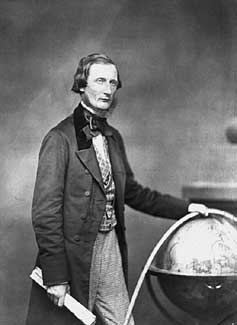
Mathew Brady Studio,
Imperial salted-paper print,
1858. 44.8 x 35.7 cm
(17 5/8 x 14 1/16 inches)
Image courtesy of
National Portrait Gallery,
Smithsonian Institution,
Washington, D.C. |
_s.jpg)
From Isabella Field Judson’s book Cyrus W. Field, His Life and Work.
Credited to Mathew Brady, 1860 |
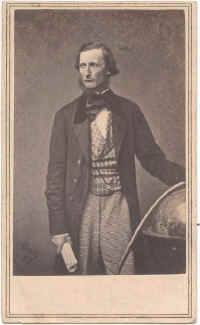
Carte
de visite
photograph
by Matthew Brady |
|
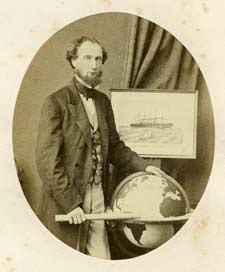
Photographer unknown,
portrait from the book
The Atlantic Telegraph (1865),
published in London, so
perhaps a British photograph. |
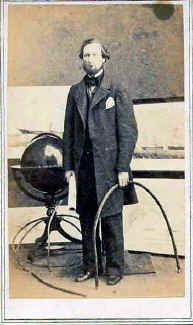
Charles D. Fredricks
& Co. “Specialite”
587 Broadway, New York |
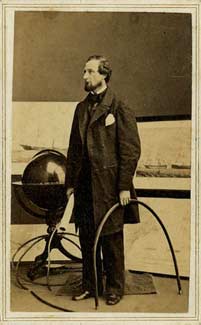
Another pose from the
same session by Fredricks |
|
|
Cyrus Field’s
Globe
When Frederic
Gisborne met with Cyrus Field early in 1854, it was with the intention
of persuading Field to invest in his Newfoundland telegraph company. Field
was not very enthusiastic about this project, but his brother, Henry,
reports:
“After (Gisborne) left, Mr. Field
took the globe which was standing in the library and began to turn it
over. It was while thus studying the globe that the idea first occurred
to him, that the telegraph migh be carried further still, and be made
to span the Atlantic Ocean.”
The globe appears in Mathew Brady’s portraits
of Field, and in other photographs, and is featured in Daniel Huntington’s
painting, The Atlantic Cable Projectors.
After Field’s death in 1892 his family
offered many of his possessions to the Smithsonian, and Field’s globe
is now in the National Museum of American History. Cyrus
Field’s will gives details of a number of his cable-related presentation
pieces and souvenirs. |
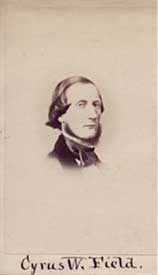
A young Cyrus Field,
photographer unknown |
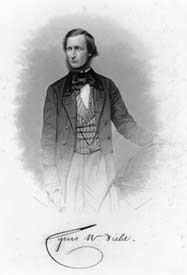
Engraving after the
Brady
carte de visite
photograph above |
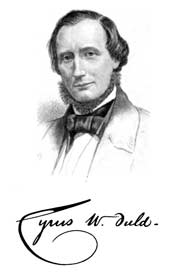
Steel engraving from The Knickerbocker, October 1858 |
|
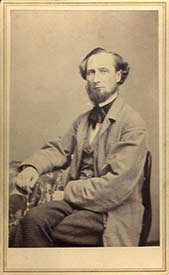
CDV by Rockwood,
839 Broadway, New York
About 1860? |
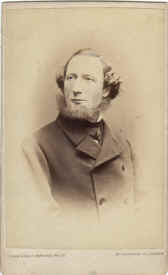
CDV by John & Chas Watkins,
34 Parliament St., London.
A little later than the Brady
photographs, perhaps early 1860s.
Click to see the
photographers’ backstamp |
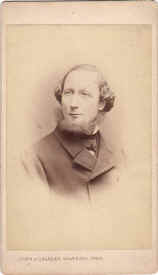
Another Watkins CDV,
a different printing of the
same image, with a
different backstamp |
|
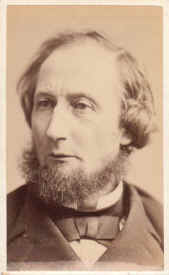
CDV by Sarony,
680 Broadway, N.Y.
Photographer’s backstamp |
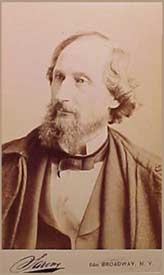
CDV by Sarony,
680 Broadway, N.Y. |
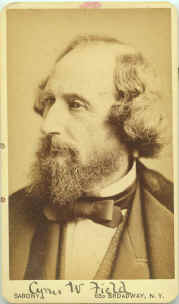
CDV by Sarony,
680 Broadway, N. Y.
Image courtesy of Jim Kreuzer |
|
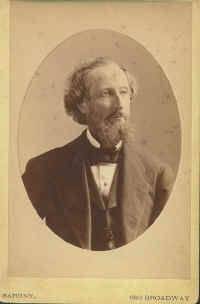
Cabinet card by Sarony,
680 Broadway, New York |
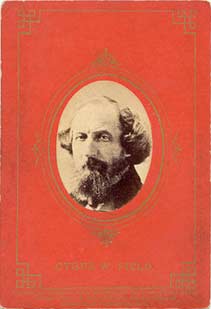
Entered according to Act of Congress, in the year of 1872, by Happy Hours Company, in the Office of the Librarian of Congress, at Washington, D.C. |
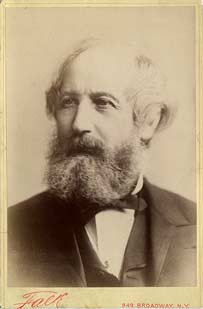
Cabinet card by Falk,
949 Broadway, N.Y. |
|
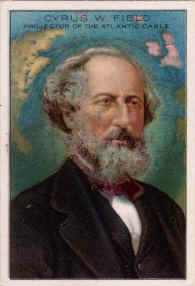
Cyrus Field, from a
1910 tobacco card in the series “Men of History”, free
with Royal Bengals Little Cigars.
Click here to see the back of the card. |
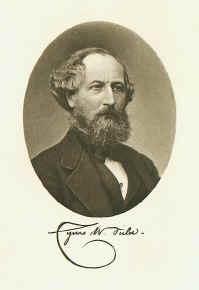
From Isabella Field
Judson’s book Cyrus W. Field, His Life and Work |
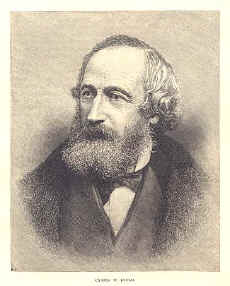
Cyrus Field, from
The Prominent Men of the New York
Stock Exchange Collection,
Harper & Brothers, 1885 |
|
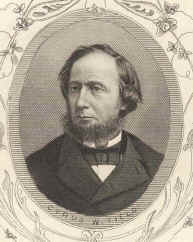
Engraving by A.B. Walter,
from the book Men of our Day
by L.P. Brockett, Philadelphia, 1872. |
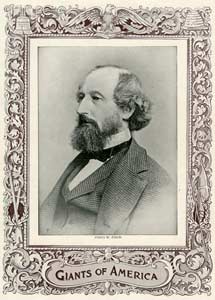
Giants of America -
perhaps a page from a book? |
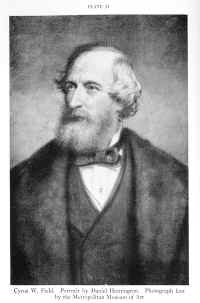
Portrait by Daniel Huntington.
Original in
Metropolitan
Museum
of Art, New York |
|
|
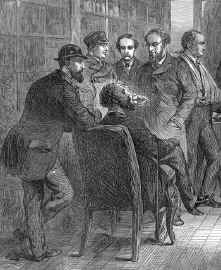
Cyrus Field on board Great Eastern,
1866, observing the test
of the
recovered cable of 1865.
From The Illustrated London News, Oct 13, 1866. |
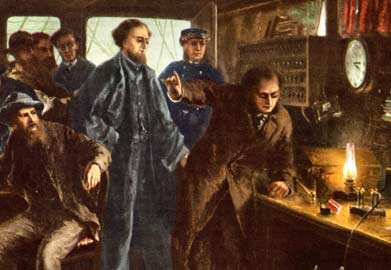
Another view of the same scene,
from the painting by Robert Dudley |
|
|
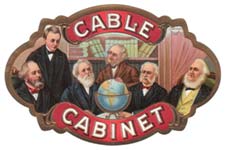
Cable Cabinet cigar
box label, circa 1895.
From the left: Cyrus
Field, Chandler White, S.F.B. Morse, Moses Taylor, Marshall
O. Roberts, Peter Cooper. This is a re-creation of the 10 March 1854 meeting at Cyrus Field’s
home in Gramercy Park, New York.
Samuel Morse was not
present at the meeting, but as company electrician he was publicly
associated with the project and the artist included him here.
See The
Atlantic Cable Projectors for more information on this meeting. |
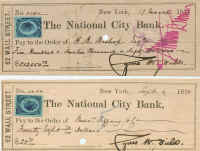
These checks were included
with a
copy of Cyrus W. Field,
His Life and Work. A pencilled note inside the
back cover of the book reads: “100 of the checks were found in
Kalamazoo Paper Mill Waste about 1920”.
One of the checks is for $512,050.00, payable to H.R. Bishop, director of construction for the New York Elevated Railroad company, which Field had taken over in 1877; the other is to Tiffany & Co.,
who sold the souvenirs of the 1858 cable,
and printed the 25th anniversary
invitations in 1879. |
|
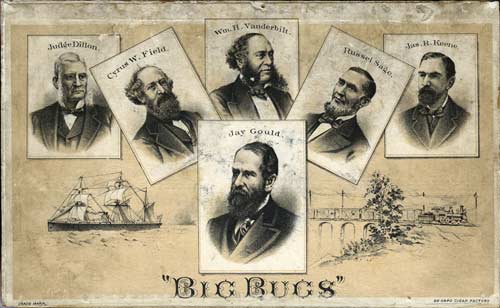
“Big Bugs” cigar box inner label. De Capo Cigar Factory
Judge Dillon, Cyrus W. Field, William H. Vanderbilt, Russel Sage, and James R Keene were all associated with Jay Gould. The date of the cigar box is unknown, but perhaps 1880s.
John Russell Bartlett’s Dictionary of Americanisms (1877) defines Big Bugs as: “People of consequence. Probably the origin of this word lies hid in some anecdote that would be worth finding out.” |
Caricature of Cyrus W Field from
The Hour (Cartoon Supplement), New York, June 5, 1880
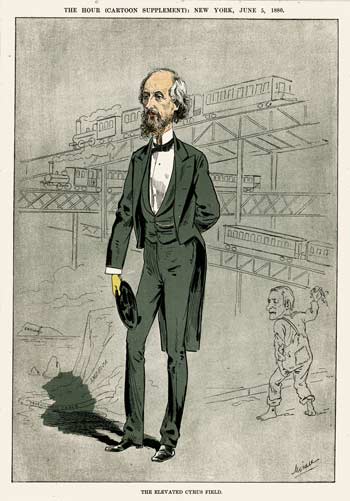
The Elevated Cyrus Field
MEN OF THE HOUR
CYRUS W. FIELD.
Mr. Field is the son of the Rev. David Dudley Field, a New England clergyman, and the brother of the lawyer who bears the father’s name, the Judge of the U.S. Supreme Court, and the Rev. Mr. Field of this city. He was born on the 30th of November, 1819, in Stockbridge, Mass. At the age of fifteen he began the business life, which he has led almost continuously ever since. He became well known in connection with the Atlantic Cable and took a prominent part in the operation of laying it. The attempt in 1857 and the first one in 1858 failed completely. In August, 1858, communication was established, but only for a few weeks. In 1865 a fourth defeat was encountered, and success only came to Mr. Field and his associates in 1866. John Bright playfully dubbed him the “Columbus of modern times.”
Since the completion of his labors in the cause of telegraphy, Mr. Field has devoted himself to the promotion of railroads, especially those running above and through the streets of New York. Common fame ascribes large gains to him, resulting from these operations. He devotes much time and pains to the entertainment of British guests, noble and otherwise, and has done his best to glorify the memory of Andre. He takes a lively interest in Williams College and indulges in fierce controversies with Samuel J. Tilden.
He is apparently in good mental and physical health and resides in the city of New York and the pleasant suburban village of Irvington.
|
|
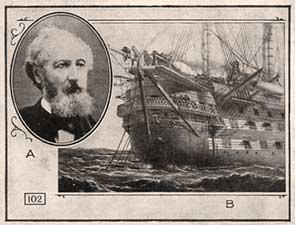 |
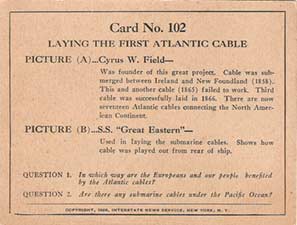 |
1926 Interstate News Service Card No. 102
“Laying the First Atlantic Cable"
This one of 120 educational cards titled “American History in Pictures" which were issued in eight sets of fifteen cards each and represented “the 120 important events in American History”. The cards were sequentially numbered in historical order. Each set was individually packaged and included an answer sheet for the questions on the cards, as well as notes for both children and adults on playing an educational game with the cards.
The Atlantic Cable card is number 102 and is part of set D-1, which along with set D-2 comprises cards covering “Beginning of the Civil War to the Present Time”. The outer packaging for each set is marked “Interstate Schools Service, Inc., New York, N.Y. Copyright 1926.”
Sadly for an educational card, the ship is HMS Agamemnon, not Great Eastern as described on the back, and the image of Field is from his later life, quite few years after the laying of the Atlantic cable. |
|
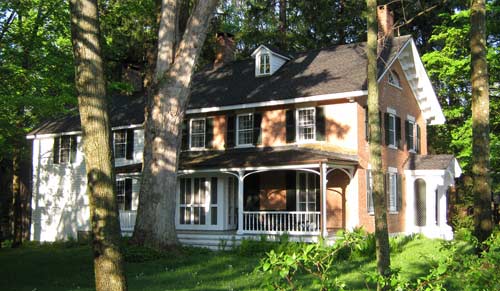
The Parsonage, Stockbridge, Massachusetts, 2010.
Cyrus Field was born here in 1819 and is buried in the
family plot at Stockbridge Cemetery across the street.
Photograph by
Barbara Allen, courtesy of Christopher Field |

Cyrus West Field and Mary Stone Field
Gravestone inscription
On th reverse of the monument, which was made in Kilkenny, Ireland, of light bluish-grey Irish limestone, is the inscription:
Cyrus West Field,
To Whose Courage, Energy and Perseverance the
World Owes the Atlantic Telegraph. |
| |
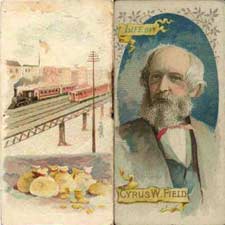
W. Duke Sons & Co., Life of
Cyrus W. Field
16-page booklet, 2-3/4" x 1-1/2",
published in the 1880s by Knapp & Company of New York as one of a series of cigarette cards for Duke’s Cigarettes.
The series title was Poor Boys Who Have Become Rich, And Other Famous People. |
_s.jpg)
Cyrus Field’s country home “Ardsley”
at Irvington on Hudson, New York
The University of Maryland has a photo album with 38 views of the 780-acre Ardsley estate. As well as Field’s own mansion, the estate included houses for each of his children, stables, kennels, an ice-house, graftery, and conservatory, among other structures. |
|
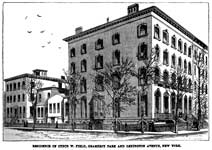 |
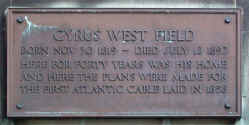 |
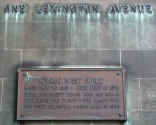 |
Cyrus Field lived for 40
years in Gramercy Park in Manhattan, at Lexington Avenue and East 21st
Street (now Gramercy Park North), the address then being 123 East 21st Street. His house (shown in 1886, above
left) was built for him in 1852, together with an identical building next door at number 125 for his brother; both were demolished in 1909. A 12-story apartment house, now a cooperative, was built on the site, and this
building has a historical marker commemorating Field and the Atlantic Cable,
which was installed in 1929 by the Gramercy Park Association.
The unveiling ceremony for the bronze plaque was held on Thursday June 20th 1929 and was attended by several of Field's descendants. The New York Times reported that Frederick A. Savage of Weehawken, Field's ofice boy at one time, was also present. The plaque remains in place today, and is shown in 2001 in the photographs above.
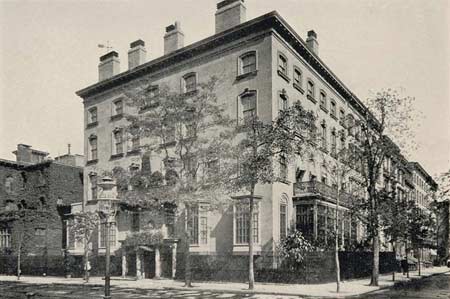
Cyrus Field’s former house in 1903. At that time it was the Henry William Poor residence; in 1902 Mr Poor had rebuilt the interior of this and the adjoining house, formerly owned by Cyrus Field's brother. As noted above, the entire structure was demolished in 1909.
Here is a Google Street View of the site today; the plaque can be seen at the corner of the building in this closer view. |
|
|
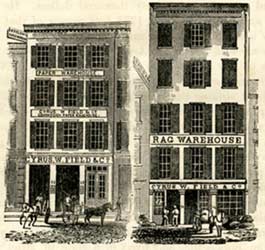
Cyrus Field’s Beekman Street Warehouse from a contemporary advertisement |
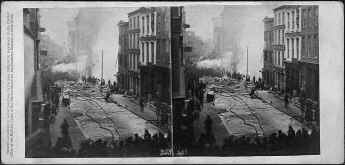
Stereoview of the 1859
fire at Cyrus Field’s Beekman Street warehouse.
Anthony’s Instantaneous Views No. 255.
Image of the back of the card |
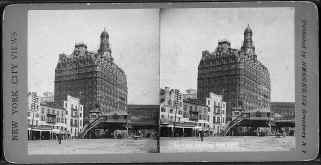
Stereoview of the Cyrus
Field
Building in New York |
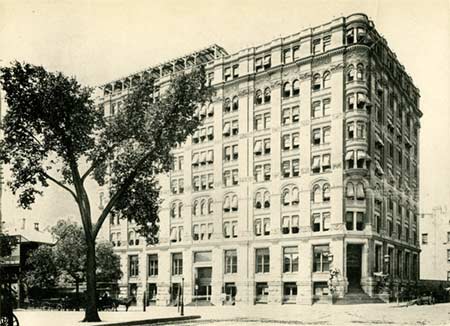
The Cyrus W. Field Building at the Battery and
Broadway,
New York.
E.H. Kendall, Architect
From The American Architect and Building News, October 9th 1886 |
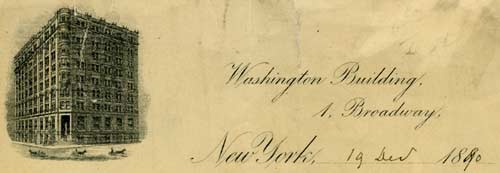
Cyrus Field’s letterhead gives the address as
“Washington Building, 1 Broadway” |
|
Cyrus Field’s wife receives very little mention in the histories of the Atlantic Cable project. Mary Bryan Stone was born in 1817 and died at the age of 74 in 1891, just a year before the death of Field himself. She bore him seven children and managed their household during her husband’s numerous long absences between 1854 and 1866.
Her calling card follows convention and her name is shown on it as “Mrs. Cyrus W. Field”, but an undated letter in her hand is signed “M.S. Field”.
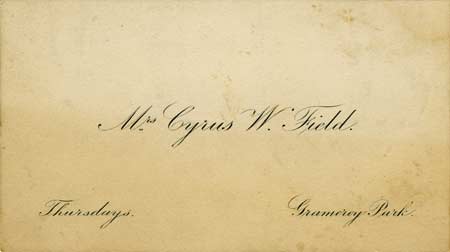
Mrs. Cyrus Field
Thuirsdays Gramercy Park |
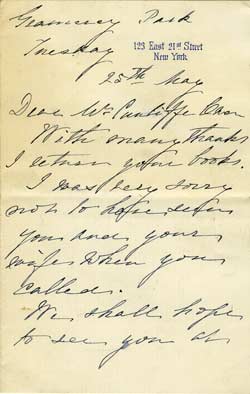
Gramercy Park, Tuesday 25th May
(Perhaps 1886 and to Frederick Cunliffe-Owen, who was living in New York City at that time) |
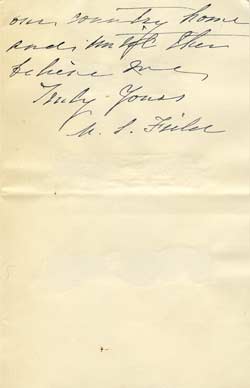
Truly Yours
M.S. Field |
|
Cyrus Field medals now have their own page, which also includes other cable-related medals and tokens
Portraits
and photographs
of Cyrus W. Field in public collections in the US are listed at the
National Portrait Gallery of the Smithsonian Institution. Click on this link and enter Cyrus W Field as Sitter Name to see the list of Field portraits.
Descendants of Cyrus W. Field. Diane Druin Gravlee, Cyrus Field’s great-great-granddaughter, has done extensive research
on
Cyrus Field and his descendants, and I am very pleased to host her comprehensive genealogy on the Atlantic Cable website.
Field Family Portraits. Peter Christian Hall and Alix-Marie Hall, New York City-based siblings whose great-grandfather was Frederick
Joseph Stone, Cyrus Field’s nephew, share images of paintings of of Cyrus Field and his parents, wife, and sons.
The Brothers Field - Russell Carpenter’s history of the five brothers of the Field family who held among them a total of 10 academic and honorary degrees from Williams College.
Cyrus W. Field, Junk Dealer. Field made his fortune as a paper manufacturer and wholesaler and needed a constant supply of rags as raw material. To this end he was licensed by the City of New-York and included in the Corporation’s “list of the licensed keepers of junk shops”. This was, of course, only incidental to his main business, although his enemies sometimes referred to him as a “junk dealer”.
The Chapin Library at Williams College in Massachusetts has an archive of Field family papers which includes material from Cyrus W. Field. Some images are on line, and the page also has links to other sources.
British Testimonial to Cyrus W. Field and his wife Mary Bryan Stone from their many friends in Britain on the occasion of their 50th wedding anniversary in 1890. |

